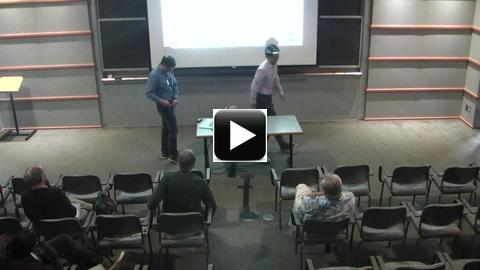The Earth system models that have been used in climate change research in recent years
typically have horizontal resolution in the atmospheric and oceanic components of
approximately 100 km. This resolution is sufficient to capture the flow instabilities of the midlatitude atmospheric jet streams that give rise to weather. However, the resolution is insufficient
to capture the dynamical analog of weather in the ocean, referred to as mesoscale eddies,
arising from instabilities of the major current systems such as the Gulf Stream, Kuroshio, and
Antarctic Circumpolar Current. While the feedback and transport effects of the ocean mesoscale
eddies on the interior of the ocean are parameterized in ocean models, this source of variability
in surface properties and air-sea interaction is missing from nearly all climate simulations. Using
climate simulations with ocean model resolution sufficient to explicitly represent mesoscale
eddies, and recently available global high-resolution satellite observations, it has become
apparent that there is a significant dynamical coupling between small-scale features in the sea
surface temperature field and the flow level atmospheric winds. The primary mechanism is
through the influence of SST on the static stability of the atmospheric planetary boundary layer.
The result is the predominance of stronger winds over small-scale warm SST features, and
weaker winds over cold. This is opposite to the sense of the co-variability on larger-scales.
There are indications that this coupling can impact larger scales in the global climate system
through scale interactions in both the free atmosphere and interior ocean.

To download: Right-click and choose "Save Link As..." (Other video options)
To begin viewing slides, click on the first slide below. (Or, view as pdf.)
![[01]](tn/01.jpg)
![[02]](tn/02.jpg)
![[03]](tn/03.jpg)
![[04]](tn/04.jpg)
![[05]](tn/05.jpg)
![[06]](tn/06.jpg)
![[07]](tn/07.jpg)
![[08]](tn/08.jpg)
![[09]](tn/09.jpg)
![[10]](tn/10.jpg)
![[11]](tn/11.jpg)
![[12]](tn/12.jpg)
![[13]](tn/13.jpg)
![[14]](tn/14.jpg)
![[15]](tn/15.jpg)
![[16]](tn/16.jpg)
![[17]](tn/17.jpg)
![[18]](tn/18.jpg)
![[19]](tn/19.jpg)
![[20]](tn/20.jpg)
![[21]](tn/21.jpg)
![[22]](tn/22.jpg)
![[23]](tn/23.jpg)
![[24]](tn/24.jpg)
![[25]](tn/25.jpg)
![[26]](tn/26.jpg)
![[27]](tn/27.jpg)